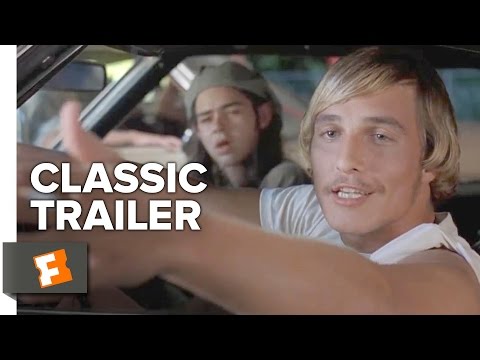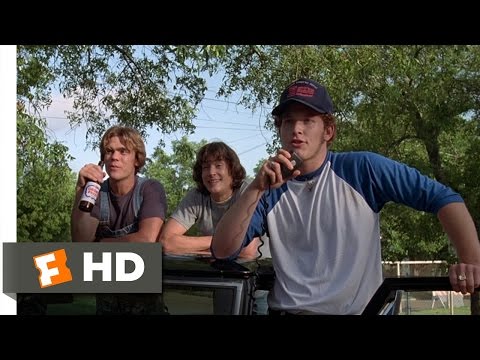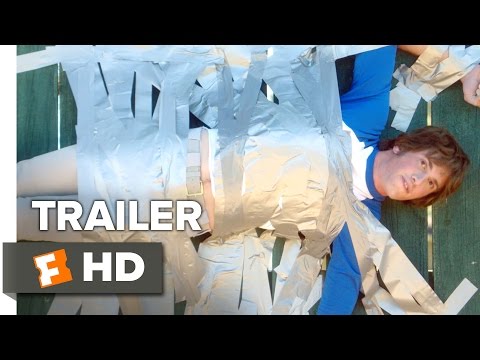Richard Linklater’s “Dazed and Confused” (1993) is set on May 28th, 1976, “the last day of school,” but never feels like a “period piece.”
There’s an authenticity here that manages to overcome the clear art direction and costume choices. Why is that?
How is that Linklater’s film, which is justly compared to George Lucas’ “American Graffiti” (1973), feels less like a facsimile and more like time travel into a lost era?
The short answer is attitude.
This is not just pageantry and art direction but a clever and full-bodied recreation of not just the ’70s but of a specific time when, in ways good and bad, we’re all blissfully young and ill-prepared for what’s ahead.

Linklater’s films offer a you-are-there, fly-on-the-wall vibe that is comparable to “American Graffiti” not only in presentation (they both share a wall-to-wall song soundtrack in which tunes are carefully utilized to suggest tones, not just soundtrack cuts) but spirit.
On this last day of school, full of rotten hazing rituals, endless after parties, personal moments of boldness, ample stupidity and some thoughtful introspection, we watch as a collection of figures emerge who feel like real, fleshed-out characters, despite some only being on screen for a few moments.
Linklater’s film has become a favorite as a “stoner” classic, but the reality is that this is great cinema, and you don’t need the film’s endorsement from The Criterion Collection to remind you, either.
The theatrical one-sheet looks great on a dorm wall but made the movie appear miss-able and dopey in a movie theater lobby. “Dazed and Confused” is not a drug movie. Unlike “Dude, Where’s My Car,” “Half Baked” or “Up in Smoke,” you don’t have to be inebriated to find this hilarious.
Another problem with the film’s release in ’93: it opened in September, but this is about the end of a school year (cue Alice Cooper!), which is hardly what anyone wants to watch as they make the painful trudge back into a classroom.
“Dazed and Confused” captures the bliss of the moment and how that momentarily eclipses the dread of what’s ahead. Linklater is depicting social rituals and contrasts the younger and older generation’s responses to them.
Hear Mixtapes Richard Linklater Made for Actors in Dazed & Confused, & Everybody Wants Some https://t.co/iQImoKu2iA pic.twitter.com/BnSN6ddtIq
— Open Culture (@openculture) June 23, 2016
There are so many great moments to lean in on, but here are a few:
The girls discussing the sexism in “Gilligan’s Island” provides an interesting contrast to the monstrous hazing ritual that takes place later outside.
Senior ritual abuse – we laugh because the teacher chuckles with recognition and because the glee of the seniors is obvious. It’s also troubling. A stoner character correctly recognizes the initiation rituals as “degrading.”
We witness the high school seniors who are actually cool (if reckless and conformist), thoughtful and good hearted, versus the ones who will grow up to become monsters later.
It’s amusing that Linklater thought to cast Matthew McConaughey, Parker Posey and Ben Affleck as the worst of the lot. No joke: Affleck’s intro line is “Y’all ready to bust some ass?”

Pink (Jason London) informs the young Mitch (Wiley Wiggins) after he survives his hazing ritual: “it’d be a cool move to show up at the party and let them know it doesn’t bother you too much.”
Excellent advice.
A subplot about a failed house party (the keg guy showed up too early!) is a recurring gag that keeps on giving and gets funnier every time Linklater returns to that house.
Everyone in the cast has a standalone moment. Most of the actors playing high school seniors appear age appropriate.
The cast overflows with actors who either hit the big time, found careers as busy character actors or strangely faded away after this opened. Standouts include Adam Goldberg, Wiggins, Rory Cochran and London.
McConaughey not only hits us with his signature “allright-allright-allright” early into his career but is even sporting a Ted Nugent t-shirt; I hate this character but I love McConaughey’s performance.
If this is the ’90s variant on “American Graffiti,” then McConaughey is to this what Harrison Ford was to Lucas’ groundbreaking and best film. Before McConaughey utters his most famous line (the one about how all the girls stay young while he ages), someone correctly prefaces it with “You’re gonna go to jail someday.”
Wiggins is not only our Everyman and audience surrogate, he even resembles Linklater (no wonder he’s also the lead of Linklater’s brilliant 2001 masterpiece, “Waking Life”). The characters are all charismatic, obnoxious and carefree.

Linklater depicts the last day of school as a prison break. There are also the close-up shots inside a foosball table – for his second movie, Linklater shows knows how to stage a scene with finesse.
This is tour de force filmmaking that still manages not to come across as pretentious or feel overly showy. The emphasis is always on character.
The period details are spot on: KISS and Alice Cooper posters adorn a bedroom wall, there are Jack Nicholson and Cooper pics in someone’s locker, Hitchcock’s “Family Plot” is playing on a movie marquee and there’s a reference to a sea monkey ad in a comic book.
There’s also a soundtrack stacked with songs that sound like AM radio bliss when listened to one after another. A restaurant with a getup that looks like a Sonic would just be a Sonic today.
The third act is put in motion by McConaughey’s suggestion of a “party at the moon tower,” a fine alternate title for this movie.
RELATED: ‘EVERYBODY WANTS’ A BETTER ’80s FLASHBACK
We watch as the high schoolers are giving in to the mythic roles of the Seniors. Over the course of the long night, we’re seeing these kids reveal their true selves and sometimes it isn’t flattering or promising.
Someone muses “Maybe the ’80s will be radical.” For some of them, it will be, though it might mean they’d have to sell out in order for the decade to work out that way for them.
Which of these kids will stick with their anti-conformist counter-culture ideals and which will add to the problems of the Me Decade and become another Gordon Gekko?
Unlike “American Graffiti,” we never got a sequel to clue us in on how things went for these teens (though the 1979 “More American Graffiti” was not an ideal sequel and only worth tracking down for completists).
On the other hand, Linklater created a terrific “Dazed and Confused” companion piece, “Everybody Wants Some!!” (2016) that covers a different decade but works as an ideal double feature.

Sometimes we witness young characters impulsively turning on each other and becoming violent, as nothing here feels romanticized, just brutally frank. The behavior on hand varies from endearing to repulsive.
Even for a high school comedy, Linklater is showing us these teens as they truly are, versus most films that aim to show us how they see themselves or fit into the stock roles of the roles.
We see how the expectations of an older, out of touch generation (such as when an old man tells a football jock about his performance and future prospects) don’t connect with this restless generation, making this similar in that way to Mike Nichols’ “The Graduate” (1967).
Another core subplot is how the high school football coach is coercing his star quarterbacks to sign a lifestyle covenant, another example of the older generation trying and failing to control the generation after it.
Linklater depicts the grownups as the gatekeepers these teens are resisting and meditating on those initial moments when we become reflective, even as we’re living what we’ll likely refer to as “the best moments.”
Pink refuses to ever refer to his high school years that way, which he’ll either regret or stick with, as his decision to defy his football coach is either the beginning of independence or a lesson to fall in line in the future.
Who knows?
The post Why ‘Dazed and Confused’ Is So Much More Than a Stoner Classic appeared first on Hollywood in Toto.